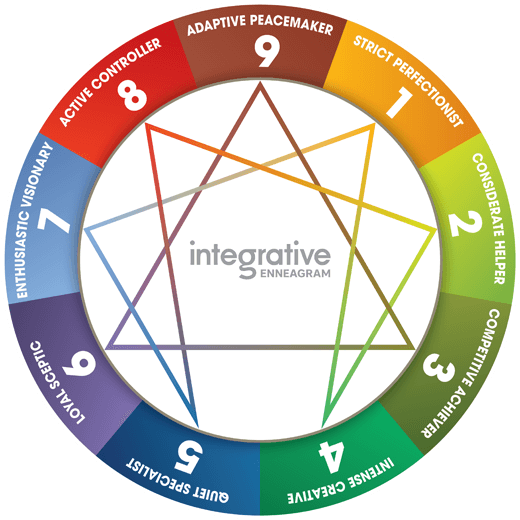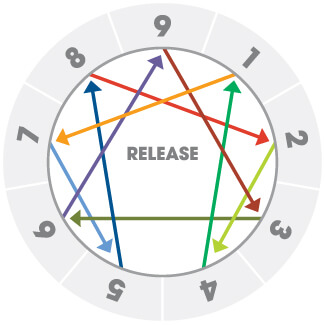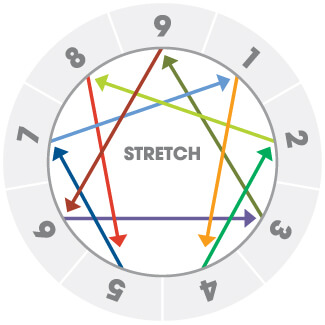The Enneagram is much more than nine points on an intersection of a triangle and a hexagon or a set of categories or types to be 'sorted into'. It is a psycho-dynamic framework that provides a powerful model for understanding how development and integration operate.
The Enneagram does not provide a 'quick fix' with a limited lifespan once insight has been reached. It enables people to develop themselves over time as the Enneagram continues to speak to us as we and our circumstances change.
Within the framework, the wings, instincts, levels of integration and lines represent the movement and journey we are on in life. The gift of the Enneagram is the richness of potential and movement it offers, flexing between core type, wings and line of release and connection, and levels of integration, to more fully exploring one's being.
There are three fundamental ways of looking at movement within the Enneagram:
Moving around the circle to connect to points on either side of your core type, 'close neighbours'.
Read More about Enneagram WingsMovement to connected points across the circle, your points of 'stretch and release'.
Read More about Enneagram LinesMovement from a 'trapped' relationship to our core type to letting go of core fears and transcending the limitations of type.
Read More about Levels of IntegrationThe Enneagram is characterized by a series of lines representing movement and influence between types. These lines indicate the dynamic interactions and energy flow patterns among Enneagram types. While our core type remains constant as our primary orientation, we have the capacity to move along these connecting lines, either intentionally or in response to life circumstances.
Each Enneagram type is connected to two others through these lines, creating a polarity or paradox to be explored and integrated. These connections are known as the Line of Release and the Line of Stretch, each offering unique opportunities for growth and development.
The Line of Release represents a path that often feels more natural and accessible. It offers a direction towards security, possibility, and stress relief. This line is particularly beneficial during challenging times, providing healthy coping mechanisms and ways to alleviate tension. It allows us to tap into positive aspects of the connected type, facilitating increased health and self-actualization.
Conversely, the Line of Stretch represents a more challenging path of growth. It encourages us to step out of our comfort zones and embrace opportunities that may initially feel uncomfortable. This line is especially useful when we feel stagnant or need significant change in our lives. It offers the potential to develop latent talents, broaden our perspective, and increase our resilience.
Moving along either line offers a significant shift in perspective, allowing us to transcend our typical reactions and develop new ways of responding to the world. These lines provide rich potential for exploration and development, offering balance and fresh resources to complement our core type.
Ideally, we work to develop fluency in navigating both lines, creating a continuum of growth. This integration allows us to access a wider range of responses and behaviors, leading to a more balanced and adaptable self.
Here is the main thing: the lines are the basic building blocks of the Enneagram, not the points. An Enneagram line is an archetype, a collection of themes, like a novel or a life. These themes are meant to be engaged, participated in, and wrestled with. Michael Goldberg Enneagram Author

The Line of Release offers a path of growth that often feels more natural and accessible to individuals. This line represents a direction of security, possibility, and stress relief. By tapping into the positive aspects of the Enneagram type at the end of this line, individuals can find healthy coping mechanisms and ways to alleviate tension, especially during challenging times.
Moving along the Line of Release allows us to explore the higher aspects of the connected type, opening doorways to increased health and self-actualization. This movement can provide a sense of balance and integration to the core type's experience, offering supportive qualities that enhance our capabilities and help us re-engage with our personal growth journey.
The Release line is particularly beneficial when we're feeling stressed, overwhelmed, or in need of regaining balance. It helps us reduce stress and anxiety, reconnect with our core values, provide emotional grounding, restore energy, and facilitate self-compassion. This path focuses on reclaiming and integrating known strengths, finding inner stability, and practicing self-care.

EXAMPLE: A stressed Two (overwhelmed by others' needs) consciously connects with the healthy qualities of Four (emotional depth, self-awareness, creativity) to understand their own needs and express them authentically, finding relief and renewed energy. However, if unconscious, this Two might become overly focused on their own feelings (like a Four), neglecting their responsibilities and becoming melodramatic.
The Line of Stretch represents a powerful pathway for personal development within the Enneagram framework. This line encourages individuals to step out of their comfort zones and embrace growth opportunities that may initially feel challenging or uncomfortable. By accessing the high side of the Enneagram type at the end of this line, individuals can balance their core type's tendencies and develop complementary traits.
Moving along the Line of Stretch offers a significant shift in perspective, allowing us to explore new ways of responding to the world around us. This journey often requires conscious effort and intentionality, as it involves developing qualities that are less familiar to our core type. The Stretch line is particularly useful when we feel stagnant, are seeking a breakthrough, or need significant change in our lives.
The benefits of working with the Line of Stretch include developing latent talents, broadening our perspective, increasing resilience, and fostering innovation. This process can lead to significant personal transformation. However, it's important to note that this path requires commitment and may feel uncomfortable or unfamiliar at times.

EXAMPLE: A stagnant Two (overly focused on others, neglecting their own needs) consciously accesses the healthy qualities of Eight (assertiveness, direct communication, taking charge) to set boundaries, express their needs clearly, and take decisive action. However, if unconscious, this Two might become domineering and aggressive (like an unhealthy Eight), pushing people away and creating new conflicts.
The Levels of Integration or Levels of Development refer to the degree of self-mastery individuals have achieved so far in their personal development journeys in life. This is a time-bound measure and will change as people invest in their personal growth, but also as their circumstances become more or less challenging.
While integration is not fixed, and people may move between high and low integration behaviours depending on context, more people demonstrate a concentration of energy and behaviour at a particular level of integration over time.
At a high level of integration one moves towards the Center of the Enneagram, able to 'play' in the wings, the lines of stretch and release, holding your core type more lightly and fluidly. This tends to moderate the core motivations, behaviours, themes and fears of an individual's main Enneagram type significantly and so individuals at high integration may be more challenging to type definitively.
The Integrative Enneagram Questionnaire broadly measures self-mastery according to three levels of integration. Even though all people may move between high and low integration behaviours depending on their context and level of strain, there is likely to be a concentration of energy and behaviour at a particular level of integration at any given point in time.
